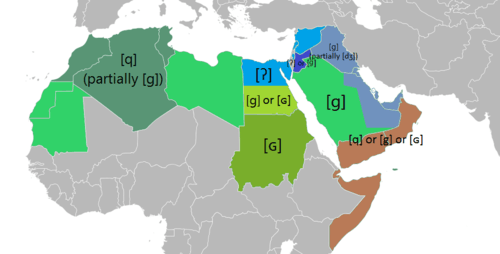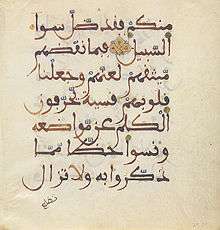Qoph
| Qoph | ||||||||||
|---|---|---|---|---|---|---|---|---|---|---|
| ||||||||||
| Phonemic representation | q (kˤ, g) | |||||||||
| Position in alphabet | 19 | |||||||||
| Numerical value | 100 | |||||||||
| Alphabetic derivatives of the Phoenician | ||||||||||
|
| ||||||||||
Qoph or Qop (Phoenician Qōp ![]() ) is the nineteenth letter of the Semitic abjads. Aramaic Qop
) is the nineteenth letter of the Semitic abjads. Aramaic Qop ![]() is derived from the Phoenician letter, and derivations from Aramaic include Hebrew Qof ק, Syriac Qōp̄ ܩ and Arabic Qāf ق.
is derived from the Phoenician letter, and derivations from Aramaic include Hebrew Qof ק, Syriac Qōp̄ ܩ and Arabic Qāf ق.
Its original sound value was a West Semitic emphatic stop, presumably [kˤ] or [q]. In Hebrew gematria, it has the numerical value of 100.
Origins
The origin of the glyph shape of qōp (![]() ) is uncertain. It is usually suggested to have originally depicted either a sewing needle, specifically the eye of a needle (the Hebrew קוף means "hole"), or the back of a head and neck (qāf in Arabic meant "nape").[1]
According to an older suggestion, it may also have been a picture of a monkey and its tail.[2]
) is uncertain. It is usually suggested to have originally depicted either a sewing needle, specifically the eye of a needle (the Hebrew קוף means "hole"), or the back of a head and neck (qāf in Arabic meant "nape").[1]
According to an older suggestion, it may also have been a picture of a monkey and its tail.[2]
Besides Aramaic Qop, which gave rise to the letter in the Semitic abjads used in classical antiquity, Phoenician qōp is also the origin of the Latin letter Q and Greek Ϙ (qoppa) and Φ (phi).[3]
Arabic qāf

The Arabic letter ق is named قاف qāf. It is written is several ways depending in its position in the word:
| Position in word: | Isolated | Final | Medial | Initial |
|---|---|---|---|---|
| Glyph form: | ق | ـق | ـقـ | قـ |
It is usually transliterated into Latin script as q, though some scholarly works use ḳ.[4]
Pronunciation
According to Sibawayh, author of the first book on Arabic grammar, the letter is pronounced as a voiced phoneme.[5] As noted above, Modern Standard Arabic has the voiceless uvular plosive /q/ as its standard pronunciation of the letter, but dialectical pronunciations vary as follows:
- [q]: In Druze dialects, most of the variants of Maghrebi, Northern Mesopotamian Arabic, a number of Yemeni accents, and partially in Gulf Arabic.
- [ɡ]: In Hejazi Arabic, Najdi Arabic, Gulf Arabic, Libyan Arabic, rural Jordan, Southern Mesopotamian Arabic and some forms of Yemeni and Sa'idi Arabic (of Southern Egypt) and partially in Maghrebi dialects.[6]
- [ʔ]: In Egyptian Arabic, as well as Levantine Arabic and forms of Algerian Arabic and Moroccan Arabic from around Tlemcen and Fes respectively.
- [ɢ]: In Sudanese Arabic and some forms of Yemeni Arabic.
- [k]: In rural Palestinian Arabic it is often pronounced as a voiceless velar plosive [k].
- [d͡ʒ]: Optionally in Iraqi and in Gulf Arabic, it is sometimes pronounced as a voiced postalveolar affricate [d͡ʒ].

Maghrebi variant
The Maghrebi style of writing qāf is different: having only a single point (dot) above; when the letter is isolated or word-final, it may sometimes become unpointed.[7]
| Position in word: | Isolated | Final | Medial | Initial |
|---|---|---|---|---|
| Form of letter: | ࢼ | ـࢼ | ـࢼـ | ࢼـ |
The earliest Arabic manuscripts show qāf in several variants: pointed (above or below) or unpointed.[8] Then the prevalent convention was having a point above for qāf and a point below for fāʼ; this practice is now only preserved in manuscripts from the Maghribi,[9] with the exception of Libya and Algeria, where the Mashriqi form (two dots above: ق) prevails.
Within Maghribi texts, there is no possibility of confusing it with the letter fāʼ, as it is instead written with a dot underneath (ڢ) in the Maghribi script.[10]
Hebrew Qof
The Oxford Hebrew-English Dictionary transliterates the letter Qoph (קוֹף) a transliteration as q or k; and, when word-final, it may be transliterated as ck. The English spellings of Biblical names (as derived from Latin via Biblical Greek) containing this letter may represent it as c or k, e.g. Cain for Hebrew Qayin, or Kenan for Qenan (Genesis 4:1, 5:9).
| Orthographic variants | ||||
|---|---|---|---|---|
| Various print fonts | Cursive Hebrew |
Rashi script | ||
| Serif | Sans-serif | Monospaced | ||
| ק | ק | ק | ||
Pronunciation
In modern Israeli Hebrew the letter is also called kuf. The letter represents /k/; i.e., no distinction is made between Qof and Kaph.
However, many historical groups have made that distinction, with Qof being pronounced [q] by Iraqi Jews and other Mizrahim, or even as [ɡ] by Yemenite Jews under the influence of Yemeni Arabic.
Gematria
Qof in gematria represents the number 100. Sarah is described in Genesis Rabba as בת ק' כבת כ' שנה לחטא, literally "At Qof years of age, she was like Kaph years of age in sin", meaning that when she was 100 years old, she was as sinless as when she was 20.
Unicode
| Character | ק | ق | ܩ | ࠒ | ||||
|---|---|---|---|---|---|---|---|---|
| Unicode name | HEBREW LETTER QOF | ARABIC LETTER QAF | SYRIAC LETTER QAPH | SAMARITAN LETTER QUF | ||||
| Encodings | decimal | hex | decimal | hex | decimal | hex | decimal | hex |
| Unicode | 1511 | U+05E7 | 1602 | U+0642 | 1833 | U+0729 | 2066 | U+0812 |
| UTF-8 | 215 167 | D7 A7 | 217 130 | D9 82 | 220 169 | DC A9 | 224 160 146 | E0 A0 92 |
| Numeric character reference | ק | ק | ق | ق | ܩ | ܩ | ࠒ | ࠒ |
| Character | 𐎖 | 𐡒 | 𐤒 | |||
|---|---|---|---|---|---|---|
| Unicode name | UGARITIC LETTER QOPA | IMPERIAL ARAMAIC LETTER QOPH | PHOENICIAN LETTER QOF | |||
| Encodings | decimal | hex | decimal | hex | decimal | hex |
| Unicode | 66454 | U+10396 | 67666 | U+10852 | 67858 | U+10912 |
| UTF-8 | 240 144 142 150 | F0 90 8E 96 | 240 144 161 146 | F0 90 A1 92 | 240 144 164 146 | F0 90 A4 92 |
| UTF-16 | 55296 57238 | D800 DF96 | 55298 56402 | D802 DC52 | 55298 56594 | D802 DD12 |
| Numeric character reference | 𐎖 | 𐎖 | 𐡒 | 𐡒 | 𐤒 | 𐤒 |
References
- ↑ Travers Wood, Henry Craven Ord Lanchester, A Hebrew Grammar, 1913, p. 7. A. B. Davidson, Hebrew Primer and Grammar, 2000, p. 4. The meaning is doubtful. "Eye of a needle" has been suggested, and also "knot" Harvard Studies in Classical Philology vol. 45.
- ↑ Isaac Taylor, History of the Alphabet: Semitic Alphabets, Part 1, 2003: "The old explanation, which has again been revived by Halévy, is that it denotes an 'ape,' the character Q being taken to represent an ape with its tail hanging down. It may also be referred to a Talmudic root which would signify an 'aperture' of some kind, as the 'eye of a needle,' ... Lenormant adopts the more usual explanation that the word means a 'knot'.
- ↑ Qop may have been assigned the sound value /kʷʰ/ in early Greek; as this was allophonic with /pʰ/ in certain contexts and certain dialects, the letter qoppa continued as the letter phi. C. Brixhe, "History of the Alpbabet", in Christidēs, Arapopoulou, & Chritē, eds., 2007, A History of Ancient Greek.
- ↑ e.g., The Encyclopaedia of Islam, Second Edition
- ↑ Kees Versteegh, The Arabic Language, pg. 131. Edinburgh: Edinburgh University Press, 2001. Paperback edition. ISBN 9780748614363
- ↑ This variance has led to the confusion over the spelling of Libyan leader Muammar al-Gaddafi's name in Latin letters. In Western Arabic dialects the sound [q] is more preserved but can also be sometimes pronounced [ɡ] or as a simple [k] under Berber and French influence.
- ↑ van den Boogert, N. (1989). "Some notes on Maghrebi script" (PDF). Manuscript of the Middle East. 4. p. 38 shows qāf with a superscript point in all four positions.
- ↑ Gacek, Adam (2008). The Arabic Manuscript Tradition. Brill. p. 61. ISBN 90-04-16540-1.
- ↑ Gacek, Adam (2009). Arabic Manuscripts: A Vademecum for Readers. Brill. p. 145. ISBN 90-04-17036-7.
- ↑ Muhammad Ghoniem, M S M Saifullah, cAbd ar-Rahmân Robert Squires & cAbdus Samad, Are There Scribal Errors In The Qur'ân?, see qif on a traffic sign written ڧڢ which is written elsewhere as قف, Retrieved 2011-August-27
External links
| Wikimedia Commons has media related to ק. |